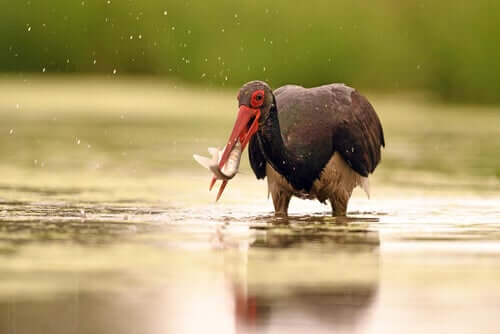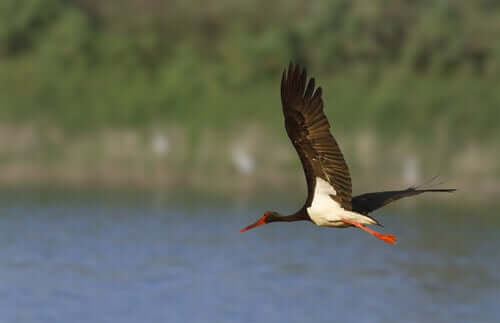All About the Conservation of the Black Stork

White storks are one of the most well-known birds in our country given the beliefs and stories that surround them. When it comes to the black stork, the situation is quite different. While black storks were probably just as abundant as white storks in the past, people are much less aware of their existence and know very little about them. This is because they are much shyer than white storks and tend to stay away from human populations.
Are these two storks really that different?
Storks belong to the Ciconidae family, which consists of 17 different species of birds. Among these, the Ciconia genus stands out especially. And, within this group, we find the Iberian storks:
- Ciconia ciconia, or the white stork
- Ciconia nigra, or the black stork
Both of these storks migrate to the Iberian Peninsula to reproduce every year. But besides the genetic closeness between both species, it’s amazing to observe how they differ when it comes to their behavior. While the white stork is anthropogenic, black storks are shy… always seeking to stay in the region’s mountains, far from humans.
Also, in regards to their number and distribution, the differences are extraordinary. While white storks are abundant, their black cousins, unfortunately, find themselves on the list of endangered species. For all of these reasons, it’s important for conservationists to come up with ideas to keep these beautiful waterbirds around.
Characteristics of the black stork
The characteristics that define these timid waterbirds are the following:
- They have a wingspan of approximately 59 inches
- Their weight is approximately 6.5 pounds
- These birds don’t have feathers on their feet, which are thin, long, and reddish in color
- These storks have a pointy reddish beak that ends in a red orbital ring
- Their feathers are completely black, except on their bellies, where they’re white

The population and distribution of the black stork in Spain and Europe
These birds live in the southwestern region of Spain, with the main population occupying the shores of the Tajo river. Experts estimate that there are about 300 to 350 reproductive couples in the country. In Europe, as a trans-Saharan migratory bird, populations exist especially in the east, where they are relatively abundant.
The habitat of black storks
The choice to settle in one area or another depends on several different factors. These include the availability of materials for building their nests and the proximity of bodies of fresh water. And, as we mentioned before, these animals prefer regions that are free of human beings.
Black storks are eminently a forest species. Therefore, they choose mature forests near the shores of rivers and lakes in order to build their nests in large trees.
The peninsular black stork is unique in that, if necessary, it can build its nest in rocky areas, due to deforestation.

The conservation of the black stork
All evidence indicates that the area of distribution, as well as the number of reproductive couples, has been decreasing over time. The causes may be:
- The destruction of mature forests and the disappearance of large bodies of water.
- The creation of roads and buildings close to the areas where these birds lay their eggs.
- Feeding areas being lost, adults being bothered during the breeding season, and the stealing of eggs.
- However, above all, the electrocution, poisoning, and illegal hunting–as is the case with all large wild birds.

The measures that are underway to protect and increase black stork populations involve developing a good rehabilitation plan, including:
- The protection and recovery of the bird’s habitat
- Reducing the mortality rate of adult birds
- Improving the success rates of reproduction through vigilance programs, and eliminating nuisances and egg-stealing
- Specialization in the recovery of storks in veterinary hospitals
All cited sources were thoroughly reviewed by our team to ensure their quality, reliability, currency, and validity. The bibliography of this article was considered reliable and of academic or scientific accuracy.
- Las cigüeñas ibéricas: la cigüeña negra y la cigüeña blanca. Colección GREFA-BCH, Nº 9. Pág.:2-8; 16.
